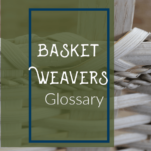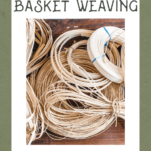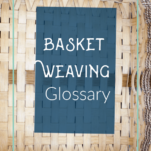Welcome to our basket weaving glossary. Whether you’re a novice or an expert, this glossary will help you navigate the intricate terms of basketry.
Basket weaving, like any craft, has its terminology and expressions. Learning these terms will help you understand the weaving process more fully. And you’ll be able to decipher weaving patterns as your skills grow.
Once you have your hands on the materials, using these terms as you work and take in information becomes more natural.
For a complete guide to all Textile Indie’s basket weaving posts and videos, visit the main Basket Weaving Page.
Printable glossary
Print our glossary for quick and easy access when learning basket weaving and reading your basket weaving patterns.
Table of contents
What are the weaves in a basket called?
Basketry finishing terminology
Basket material terminology
Rattan
Reed
Using rattan, the inner core of the vine is cut into lengths of different shapes to create a reed. The reed is cut into round, flat, flat-oval, half-round, or oval shapes. Reed is used in basket weaving and furniture making.
Related post:
Check out the Beginners Guide to Basket Weaving Materials, where I go into more detail on basket-weaving materials

Flat reed
Reed with two flat sides.

Flat-oval reed
Reed cut so that one side is flat and the other side has a rounded surface.

Round reed
Reed cut in a cylinder.

Half-round reed
Reed that looks like a half-moon in profile. One side is flat and the other side is rounded, more dramatically than the flat-oval reed.
Cane
Cane is made from the outer layer of the rattan vine. Cane is another material that can be used in basket weaving.
Binder cane
Cane cut wider than normal is binder cane.
Handle
Part of a basket, used to conveniently carry the basket.
Related post:
For an in-depth look at basket handles, see the Beginners Guide to Basket Handles.
Related video:
D handle
A handle that has a flat bottom and curves around to create a ‘D’ shape.
Hoop
A piece of wood or reed that has been formed into a ring. Hoops are used in ribbed baskets.

Seagrass
A twisted rope of grass.

Ash splints
Strips from an ash tree that are cut and thinned to be used as stakes and weavers. Used in split-ash basketry.
Oak splints
Strips from an oak tree that are cut and thinned to be used as stakes and weavers.
Do you want the best resources, tools, and products for fiber artists?
Every other Friday, I send an email chock full of fiber craft inspiration for you to explore.
Each issue focuses on one fiber art skill – spinning, dyeing, basket weaving…
Basketry tool terminology
Related post:
For a complete explanation of basketry tools, see, Basket Weaving Tools: What you Need to Get Started
Related video:
Straight tipped packer
A flat-headed awl that is used in rattan basket making to pack the weavers together. The straight-tipped packer also assists in lashing the rim, and other techniques.

Spoke weight or stake weight
A heavy metal bar is used to hold stakes in place when setting up a basket base.
Awl
Consisting of a handle and a rod of metal that comes to a point at the end. Used to open spaces and create holes in reed.
Reed cutters or reed scissors
Sharp, short-bladed scissors for cutting reed.
Metal and plastic clamps
Metal clamps: small spring-loaded clamps made of metal with rubber coating.
Plastic clamps: plastic spring-loaded clamps.
These are used at different stages in the basket weaving process to hold things in place and act as a third hand.
Basket weaving terms
Basket hairs
Small fibers that stick up on rattan reed.
Stakes or spokes
The pieces of reed that form the foundation of the basket. They are like the bones of the basket – creating the base and the shape.
The term stake is typically used for baskets made of flat reed. Spokes generally refers to baskets that have ribs made of thick round reed.

Weaver
A piece of reed that you are currently using to weave with.
Or the pieces of reed that are woven into the walls of the basket.

Soaking
Placing pieces of reed in a tub of water.
Soaking keeps the reed pliable and easier to handle as you weave so that it doesn’t crack or break.

Base
The bottom of the basket.
Open base
A basket base that’s woven in a grid, leaving open spaces between the stakes.
Related post:
How to Weave an Open Basket Base

Closed base
A basket base that’s woven with added weavers between each stake to close the spaces between the stakes.
Related post:
How to Weave a Closed Basket Base

Related videos on weaving a basket base:
Do you want the best resources, tools, and products for fiber artists?
Every other Friday, I send an email chock full of fiber craft inspiration for you to explore.
Each issue focuses on one fiber art skill – spinning, dyeing, basket weaving…
Twining
Twining is a technique used to hold the base in shape after all the stakes have been placed and squared up.
Its a process of weaving with a length of round reed that’s been folded in half. The loop it placed over a stake and then the two ends are crossed over in between each stake.
Related post:

Upsetting the basket
After the base is woven and the twining is done to hold the stakes in place, you fold the stakes upright to create a crease at the base of the stake.
Upsetting begins to form the walls of the basket.

Packing
The process of sliding all layers of weavers towards the base to ensure they are tightly spaced.
Cut and tuck
Cut and tuck is the process of folding over stakes and cutting them around the top of a basket in preparation for the rim.
The stakes that sit in front of the top weaver get folded over the weaver creating a “lock” that holds everything in the interior of the basket.
Stakes that sit behind the top weaver get trimmed off flush with the upper edge of the top weaver.
The result is an alternating cut-and-tuck series around the top of the basket.
Related post:
How to Set up the Rim on a Basket

Rim
The upper edge of the basket.

Scarf
A joint where the ends of two pieces of reed are cut so that they meet or overlap firmly.
Scarfing
Trimming down the ends of a rim reed so they have less bulk when they overlap.

Lasher
The reed used to do lashing.
Lashing
A process of “whip stitching” a lasher around the rim to hold it in place.
Related post:
How to Do Basic Lashing on a Basket Rim

Cross-stitch lashing
Lashing is done around the rim of the basket, going around in one direction and then repeated back over the previous work in the other direction. The stitch creates a cross-stitch or ‘x’ shape around the rim.
Related post:
How to Do Cross-Stitch Lashing on a Basket Rim

Crow’s feet, also called chicken feet
Crow’s feet are used in closed base baskets. The filler stakes are folded into the basket and under the base stakes to create ‘v’ shapes on the inside of the basket.

Bevel
To trim a square edge down to a sloping edge.
Bi-spokes
Extra spokes added after the original set of spokes.
Braided handle
A braid that is woven around the handle of a basket.
Butt
To bring any two ends of material flush against each other.
Double-bottom
A technique where a basket is woven with two bases. One base is woven and then a second base is woven on top.
Ear
A point on a basket where the rim and handle intersect – lashing or weaving is done around this point to hold it securely.
Frame
A support around which a basket is woven. Frames are used in shaped baskets.
Losing a lasher
Losing a lasher refers to hiding the the end of the reed in the rim or in the weaving.

Notch
An indentation in a push-in handle that holds the handle in the wall of the basket and prevents it from coming out.
Plaited
Another term for woven.
Randing
An over-under weave done with a single weaver over an odd number of stakes.
Rib
Round or oval pieces that form the skeleton of a basket from one side of the basket to the other.
Rim filler
A piece of material placed between the inner and outer rim to fill the gap above the basket walls.

Stepping up
Stepping up is used in twill weaving. It describes the process of starting a new row one stake to the right or left of the beginning point on the previous row.
Stroke
The movement of the weaver. Each time it goes behind or in front of a stake that is a stroke.
Double wall
A basket that has an inner wall and an outer wall. Essentially two baskets woven into one.
Dyeing
Dyeing is a process of adding color to the reed by soaking it in a pot of boiling dye.
What are the weaves in a basket called?
Plain weave
Also known as simple weave.
Plain weave is done by following an over one, under one pattern of weaving.
The over one, under one pattern alternates from row to row so that the stakes are also going over one, under one vertically.

French randing
This is a technique used to create a diagonal weave in the walls of a basket. French randing is great for using up shorter pieces of reed. It’s done by weaving the base of a basket as normal and then weaving the walls up at a forty-five degree angle.
Twining
Twining uses two pieces of round reed to crisscross around each stake in a basket. The process creates a cross between each stake.
Twill weave
Twill is a technique used to create a diagonal stairstep effect on the walls of a basket by weaving with an even number of stakes. There are two main types of twill a 1-2 twill and a 2-2 twill.
Twill 1-2
This twill is called a one-to-two-twill. This is when the weaver goes under one and over two around the basket and then alternates as you proceed with the rows.
Twill 2-2
This twill weave, called a two-to-two-twill, is where the weaver is going over two stakes and then under two stakes. The next row alternates that pattern so that a stair step pattern forms.
Wave
A wave adds a weaver to the sides of a basket that crosses over the working weavers creating an ‘x’ shape on the outside of the basket.
Basketry Immersion: A Year-Long Journey
Check out Textile Indie’s self-paced basket program if you want to learn to weave beautiful baskets.
Twelve different basket designs with video and written instructional support to learn foundational basketry techniques.
Over the course of twelve months, you will receive one basket pattern and a video with supporting instructional material each month. Start at basket one and weave all twelve.

Weave brake terminology
Brake
A weave brake refers to the point when you end one row, or weaver and begin a new row or weaver.
Start-and-stop weave
One row at a time weaving. It’s done by weaving all the way around, overlapping the ends, and tucking them out of sight.
Continuous weave
Continuous weave is a technique often used in a round basket where the weaver is woven around and around until you reach the end of the weaver. You will continue adding weavers until the walls are complete.
Chase weave
Chase weave involves two weavers being woven at the same time. The ends of the weavers are trimmed down and woven into the basket, on the same side, so as the walls form, they are even.
When you get to the end of one or both of the weavers you add in a new length of reed just like you would for a continuous weave.
Basket finishing terminology
Aging
Reed darkens as it cures and ages.
Sealing
Finishing the basket with a sealer to protect it from the elements and dirt.
Sealer
A sealing product is used to seal the reed of a finished basket.
Stains
A mixture of products used to change the color of the basket reed to a desired hue.
Staining
Using a stain to finish a basket and change the color of the reed to appear a different shade.
Related post:
Basket Stains and Sealers: Finishing Your Baskets

Related video:
Printable glossary
We hope this basket-weaving glossary serves as a valuable resource as you delve deeper into the world of basketry.
Print our glossary for quick and easy access when learning basket weaving and reading your basket weaving patterns.















